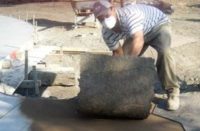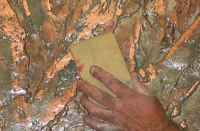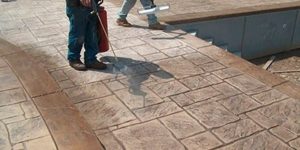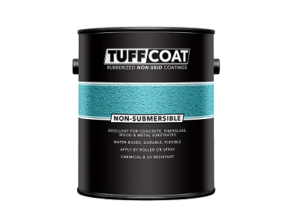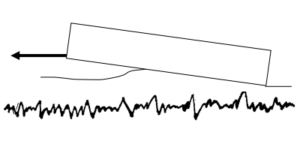Contractors and building owners alike are at risk when they install flooring that can contribute to an accident in which someone slips and falls. These accidents account for thousands of deaths and far more injuries each year. To prevent them, government and industry have developed codes and guidelines designed to make floors safer to walk on.
In the interest of developing a scientific way to determine how slippery a surface is, measurements of slip resistance have been developed. In the United States, slip resistance is determined by measuring the static coefficient of friction (SCOF) of a surface. SCOF is defined as the force required to start relative motion between an object and the surface it is resting on. Europe and Australia have used measurements of the dynamic coefficient of friction — the force required to keep a sliding object in motion once sliding has begun — but these measurements have not gained acceptance in this country.
SCOF can be measured using a variety of instruments, each of which may cost thousands of dollars, and no single one is universally accepted among experts. This controversy poses a difficulty for the flooring contractor that just wants to lay safe flooring. Each contractor is well advised to research the methods before choosing an instrument to invest in or a test lab to use.
In the United States, the most widely accepted and best-known evaluator of slip resistance measurement methods is the American Society for Testing and Materials (ASTM). The society publishes standards describing each instrument for determining SCOF, how it is to be used, and the results of scientific testing to determine how valid it is. ASTM has indicated that most methods can be used only for dry surfaces because liquid sandwiched between two resting surfaces interferes with accurate measurement by opposing the force needed to initiate motion. This is unfortunate, because most slips occur on wet surfaces, which are usually more slippery than dry surfaces.
Some of the most widely used instruments to measure slip resistance are the horizontal pull slipmeter (HPS), described by ASTM standard F609; the James machine, ASTM D2047 and F489; the Brungraber Mark I slipmeter, ASTM F462; and the English XL variable incidence tribometer, ASTM F1679. Each of these instruments has its advocates and all are in active production today. Among the four, the James machine is too large and heavy to be portable, so samples for testing with it must be sent to a laboratory. Dozens of additional devices exist; these are simply four of the most popular.
Decades of testing have established an SCOF of 0.5 to be the generally accepted threshold of safety for flooring. A lower SCOF is too slippery to be considered safe. Building codes and OSHA regulations have incorporated the 0.5 standard. Regulations implementing the Americans with Disabilities Act, however, have established that people who use mobility aids such as wheelchairs, walkers and crutches need a more slip-resistant surface. Minimum SCOFs of 0.6 for flat surfaces and 0.8 for ramps are recommended under the ADA, although these are not legally binding codes

The slip resistance of concrete flooring varies, but a typical dry unfinished concrete surface may have an SCOF of 0.8. Sealed concrete generally has a lower (more slippery) measurement. Wet surfaces will usually be more slippery still. Wet concrete has been measured by the government at as low as 0.16. It is advisable for contractors installing sealed concrete to have their slip resistance tested. It’s also important to consider slip resistance when preparing a floor for an area that will frequently get wet, such as a restaurant floor, pool deck, or entranceway.
When it’s desirable to enhance a concrete surface by making it more slip resistant, a variety of sealer additives can be used. In order to be effective, the gritty additive must poke above the level of the sealer and through any standing water or contamination to engage with the sole of the shoe or a crutch tip. The tiny projections of the grit are known as asperities. Jagged asperities can be more effective at keeping a shoe from slipping, but round particles can be embedded more firmly in the sealer, so additive manufacturers have put considerable effort into working toward an ideal compromise.
Additives can be broadly classified into polymer and mineral types. Acrylic polymer additives are synthetic granules that can be manufactured in round or flake shapes. Suitable for residential or light commercial applications, they have a shorter lifespan of contributing slip resistance than the mineral types because they are softer and they wear down. Because they are lightweight, they are easy to apply — simply mix in the recommended proportion of granules with the sealer and apply. The product will clog most sprayers, so the sealer will need to be rolled on. Polymer additives are clear to pale white in color so they offer minimum impact on the appearance of a surface.
Mineral additives include glass, quartz and silica sands, and bleached aluminum oxide. These materials are significantly harder than synthetics and will stand up to heavier traffic for more years. Aluminum oxide is considered the ultimate material for heavy duty slip resistance. Each type of additive is available in a variety of mesh sizes for a different fineness of grit, yielding a different texture and different SCOF on the finished floor. Most minerals are too heavy to be suspended in sealer by mixing in and must be broadcast on the floor. Most contractors recommend applying sealer, broadcasting the additive, and then applying a second layer of sealer. The additive is often applied with a roller, although experienced installers can sometimes achieve good results with a shaker can or even broadcasting by hand. Mineral additives are typically more opaque than polymers, so they affect the appearance of a surface more.

No matter what additive is chosen for the application, it is important to make sure that it is properly applied so that 30 percent to 50 percent of the particle is embedded in the resin matrix. If not enough of the particle is embedded, it may become dislodged over time. If too much resin is applied, not enough of the particle will form asperities to contribute to slip resistance. For example, 60 mesh aluminum oxide has a height of approximately 10 mils and needs to be embedded in 3 to 5 mils of resin.
The textured surface of a floor with slip-resistant additives should not be difficult to maintain. No special care is required. In food surface areas that become contaminated with grease, a standard floor maintenance program should involve scrubbing with a floor machine using an aggressive black pad or nylogrit brush with a good commercial degreaser. Custodians should rinse the floor well to remove any detergent residue and either vacuum the rinse water or flush it down the drain.
Contractors that seal concrete floors need to become familiar with slip resistance issues for their own self protection as well as for the benefit of their customers. Investigate and choose an instrument or test lab service for measuring SCOF, develop competence at selecting and applying additives that enhance slip resistance, and keep up to date with new products and procedures in the industry. The result will be wisely managed liability and better safety for users who walk on the finished floors.

